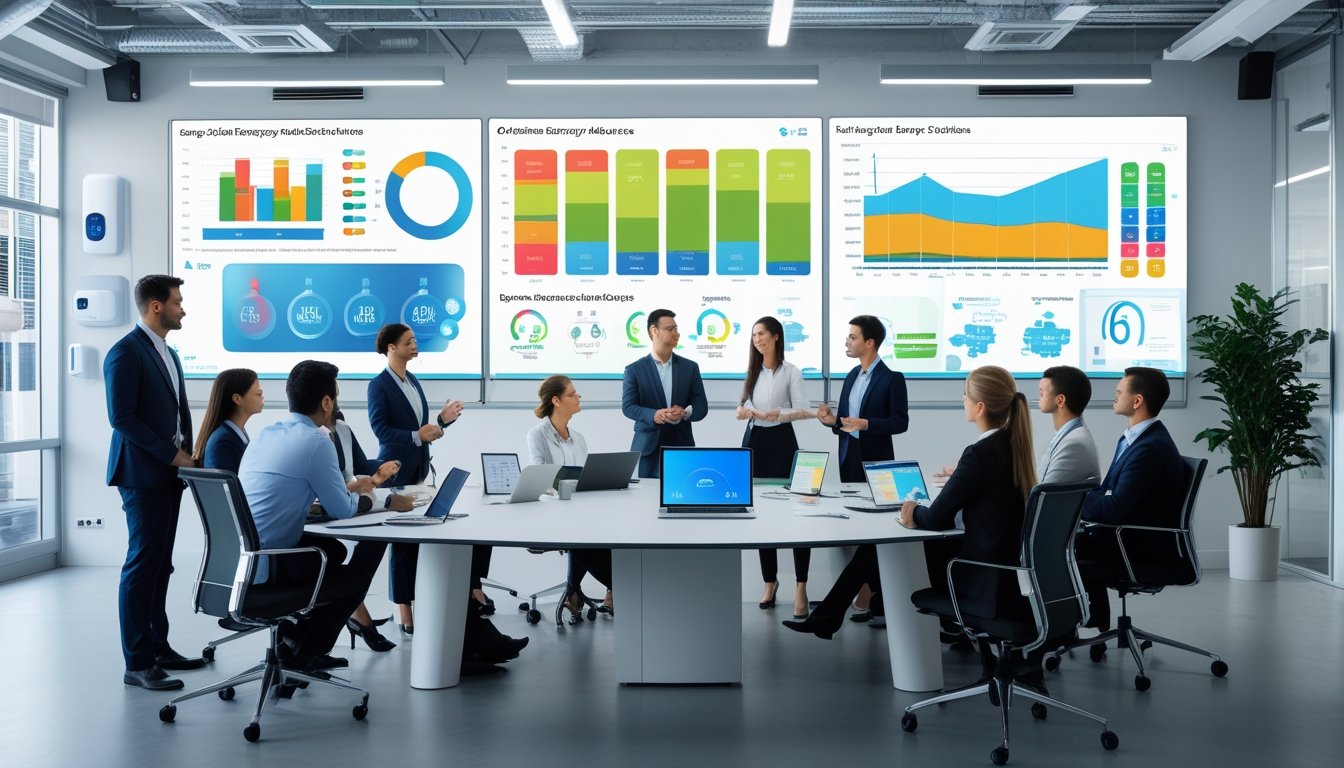Late updated: 05 Nov 2025 13:11
Written by: Amber Collins
Optimising Business Energy Use With Smart Solutions: A Guide to Efficiency
In today's fast-paced business environment, efficiency and sustainability aren't just buzzwords; they are essential components of success. Whether you manage a small startup or a large corporation, optimising energy use can lead to substantial cost savings and a reduced carbon footprint. By adopting smart energy solutions, we can significantly enhance our operational efficiency and contribute to a more sustainable future.

Embracing technologies like IoT-enabled systems, smart sensors, and automated controls gives us the power to monitor and manage energy consumption in real-time. These tools provide valuable insights, enabling businesses to identify waste, optimise power usage, and implement energy-saving strategies effectively. With the global energy landscape evolving, it's crucial to stay ahead by incorporating innovative solutions that will drive growth and sustainability.
The benefits of smart energy management extend beyond mere cost reduction. By implementing these strategies, businesses not only improve their bottom line but also align with environmental goals and regulations, enhancing their reputation and competitiveness in the market. The following sections explore key strategies and frequently asked questions about smart solutions and energy efficiency.
Key Takeaways
- Smart solutions improve efficiency and sustainability.
- Real-time monitoring identifies and reduces energy waste.
- Energy management supports cost savings and compliance.
Key Strategies for Optimising Business Energy Use

Optimising energy use is essential for reducing costs and enhancing operational efficiency. By assessing energy consumption, implementing audits, and reducing waste, businesses can significantly lower their utility bills and improve their environmental impact.
Assessing and Understanding Energy Consumption
Understanding our energy usage is the first step towards optimisation. We must identify areas of high consumption and inefficiency. This involves analysing historical energy bills to pinpoint trends and patterns in energy use.
By doing so, we establish a baseline which enables us to set realistic reduction targets. Knowing how much energy each process or equipment uses helps us prioritise which areas to address first.
Emphasising the importance of data collection through smart meters or digital platforms can provide real-time feedback. This approach enables us to make informed decisions about where to focus our energy-saving initiatives, enhancing overall energy efficiency.
Implementing Energy Audits and Monitoring
Conducting regular energy audits is key to identifying inefficiencies and potential cost savings. An audit involves a detailed analysis of our energy use, including lighting, heating, cooling, and equipment performance.
Engaging professionals for these audits ensures a comprehensive understanding of potential energy-saving opportunities. Moreover, continuous monitoring through advanced systems allows us to keep track of our energy performance.
With tools such as smart sensors and IoT devices, we can automate this process, enabling proactive maintenance and timely interventions. This not only lowers our operational costs but also extends the lifespan of our equipment by preventing unnecessary wear and tear.
Reducing Energy Waste and Operational Costs
Reducing energy waste is crucial for cost savings and environmental responsibility. Effective strategies include upgrading outdated equipment to more energy-efficient models and optimising operational schedules to align with periods of lower energy demand.
We can implement measures like automatic lighting controls and HVAC system improvements to prevent unnecessary energy use. Regular maintenance of equipment ensures peak efficiency, reducing both energy waste and maintenance costs.
By fostering a culture of sustainability among employees, encouraging small changes, such as turning off unused equipment, can result in substantial energy savings. This comprehensive approach helps us align business energy management with modern sustainability goals, achieving a balance of efficiency and environmental stewardship.
Smart Solutions and Technologies for Enhanced Efficiency
In today's dynamic business environment, optimising energy use is essential. Smart solutions offer businesses the opportunity to enhance efficiency. This involves incorporating energy-efficient equipment, leveraging automation and data analytics, and integrating renewable energy sources.
Energy-Efficient Equipment and Upgrades
Investing in energy-efficient equipment is a practical approach for businesses aiming to reduce energy consumption. Upgrading lighting systems to LED options provides immediate benefits. They consume significantly less power and have longer lifespans than traditional bulbs. Similarly, modernising HVAC systems can lead to substantial energy savings. Smart thermostats and automated lighting controls further optimise climate management and illumination. Insulation upgrades also prevent energy loss, ensuring that buildings maintain energy efficiency. The integration of smart meters allows real-time monitoring of energy use, providing valuable insights to make informed decisions.
Automation, Controls, and Data-Driven Management
Automation in energy management is pivotal for enhancing efficiency. Automated controls regulate energy use, adapting to real-time demands without manual intervention. Predictive analytics play a critical role by forecasting energy needs, enabling proactive adjustments. Energy management software offers comprehensive data analysis, facilitating informed decisions on operational improvements. These tools help pinpoint inefficiencies and guide targeted energy-saving initiatives. Automated compressed air systems detect and reduce air leaks, which are often invisible energy wasters. By adopting these technologies, businesses can not only minimise operational costs, but also achieve sustainability goals.
Integrating Renewable Energy and Sustainable Practices
Fusing renewable energy sources with existing infrastructures is an essential strategy for long-term sustainability. Installing solar panels or wind turbines contributes to a significant reduction in carbon footprint. These options provide clean energy, decreasing dependence on traditional power sources. Furthermore, aligning energy efficiency projects with corporate sustainability objectives solidifies environmental goals. Emphasising sustainability efforts supports both operational and reputational excellence. Encouraging employees to participate in energy-saving practices enhances this culture, making sustainability a shared responsibility. By integrating these solutions, businesses position themselves as leaders in environmental stewardship, paving the way for a greener future.
Frequently Asked Questions

In the drive to optimise energy consumption within businesses, understanding effective strategies and integrating advanced technologies becomes vital. Let's address some common queries to help maximise the efficiency of energy use in the workplace.
What are the most effective strategies for reducing energy consumption in the workplace?
Reducing energy consumption involves implementing smart technology, optimising equipment usage, and adopting energy-efficient practices. Simple actions, like switching off lights and utilising energy-efficient lighting, contribute significantly. More advanced strategies include using energy management systems to monitor and adjust energy usage in real-time for maximum efficiency.
How can smart technology contribute to energy efficiency within companies?
Smart technology, such as IoT devices and automated control systems, enables precise monitoring and adjustment of energy consumption. These technologies provide detailed insights and allow businesses to automate energy usage based on demand. This capability reduces waste and enhances efficiency, supporting both cost savings and sustainability.
What are the initial steps in conducting an energy audit for a business?
The first step in an energy audit is data collection, focusing on current energy consumption patterns. We then analyse this data to identify inefficiencies and opportunities for improvement. Engaging with experts to conduct a thorough evaluation can uncover actionable insights to drive energy-saving initiatives.
How does energy management software aid in monitoring and reducing energy use?
Energy management software offers detailed analytics and visualisations of energy consumption. It supports businesses in identifying patterns and inefficiencies. Automating controls and generating alerts for atypical usage, the software enhances the ability to respond to energy trends promptly, driving both savings and operational efficiency.
Can you suggest ways that renewable energy can be integrated into business operations?
Incorporating renewable energy can be achieved through several methods, such as installing solar panels or utilising wind energy. Joining community energy initiatives or investing in carbon offset programmes also supports renewable integration. Businesses can convert energy costs into long-term investments by adopting these sustainable sources.
What financial incentives are available for businesses that invest in energy-efficient technologies?
Many regions offer financial incentives like tax credits, rebates, or grants to encourage investment in energy-efficient technologies. These incentives reduce the initial cost burden for companies. Taking advantage of these schemes not only supports financial savings but also contributes to broader sustainability goals.
